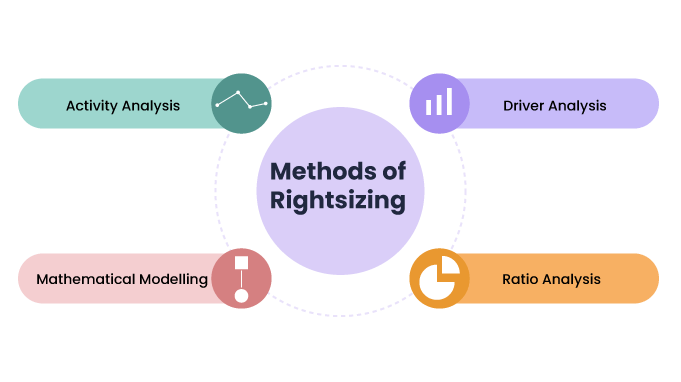Understanding Rightsizing in HRM in the Right Way
Considering the economy's recent rebound, businesses are forced to be flexible with their strategies. This includes rightsizing. A term that refers to reducing an organization's workforce and allocating resources more efficiently.
Rightsizing may sound like an ominous term to those unfamiliar with it. In reality, it is just a simple process of removing the outliers and building the workforce that brings the best possible business results.
Let's learn more about rightsizing in HRM and how it impacts modern organizations.
Definition of Rightsizing
In HRM, rightsizing is the process of managing the changing needs of an organization. Nowadays, adverse economic conditions have forced all organizations to cut their workforce.
If you're going to reshape your company or team, you need to know a thing or two about the rightsizing process.
Rightsizing is restructuring a company to improve business performance and profitability, regain profit, and reduce operational costs. Hence, it is also sometimes included in organization restructuring.
The goal of rightsizing is to make a company more profitable and meet its updated business objectives.
While people often confuse "rightsizing" with "downsizing," the terms are different with different concepts.
Difference Between Rightsizing and Downsizing
When it comes to downsizing and rightsizing, it is important to note that they are two different processes.
Downsizing involves reducing the number of employees to keep costs low and maintain profits or achieve higher levels of profitability.
On the other hand, rightsizing is a process whereby companies re-evaluate their structure and adjust it to meet new business objectives without necessarily impacting overall headcount numbers.
When companies downsize, they do so to avoid going out of business. But when companies rightsize, their major focus is on achieving their business goals to optimize profits.
Methods of Rightsizing

1. Drivers Analysis
This is one of the simplest methods of determining the workforce of an organization. The process is by analyzing the primary factors behind the operation of a business.
For instance, the success drivers for an advertising agency will be the number of clients, volume of projects, skills required, etc.
Making a simple analysis can help you determine the exact size of the workforce you actually need.
2. Ratio Analysis
Ratio analysis is one of the most common methods used by organizations. In this method, certain variables like labor, material, sales are shown concerning each other.
Organizations perform ratio analysis to determine how their resources are utilized. Using these ratios, they plan the necessary restructuring. Some of the methods are:
-
Productivity Ratio - Productivity ratio is generally described as output volume to input volume. It assesses how effectively production inputs such as labor and capital are utilized in an economy to generate a certain amount of output.
-
Turnover Ratio - A turnover ratio is the number of assets or liabilities replaced by a company in relation to its sales. The ratio is important for measuring how efficiently a company uses its assets.
-
Cost Per Hire Ratio - The cost per hire refers to the entire cost of hiring a new employee and bringing the employee onto the team. It includes the expense of the recruitment process, equipment, travel costs, administrative fees, and benefits. Calculate it using our extensive cost per hire calculator.
3. Activity Analysis
The objective of activity analysis is to find out the most effective and efficient way of performing the assigned task.
This entails calculating how much time each person spends on their primary tasks.
It's important to differentiate between what people actually do and what their job descriptions claim they do. So, an activity analysis can be of really great help in observing the time spent by the employee on their tasks.
Some of the common parameters of analysis are -
- Duration
- Productivity
- Speed
- Workload
Related: 9 Time Management Techniques For Better Engagement
4. Mathematical Modelling
It involves developing mathematical models to calculate the exact number of employees required in the organization. It can sometimes prove to be a challenging and time-consuming process.
As a result, many organizations do not adopt this process due to its complexity.
Benefits of Rightsizing
Let's look at some of the benefits of rightsizing.
1. Maximize Profits
The benefit of rightsizing is that it helps your business become more profitable by cutting out anything that's not helping your business grow. It gives you a clear view of how your business is performing. This can help you to identify any problem areas and address them.
When you rightsize your business, you take advantage of your full potential while also identifying areas to improve.
2. Get Rid of Redundancies
Often, businesses have redundant procedures in place because they're working with the same old software or equipment. Rightsizing helps you eliminate procedural redundancies as well as staff redundancies. Find out if you have multiple people performing the same task or unnecessary steps in a process that could be eliminated.
Rightsizing can help you streamline your workflow by cutting down on overhead costs and investing your money in profitable areas.
3. Get Better at Hiring Decisions
When it comes to making the perfect hiring decision, you have to have an idea of what you're looking for, and then you have to find people who fit that mold.
Rightsizing is all about getting rid of the people who aren't a good fit for your company. It helps you simplify the decision process by questions like:
- Do we really need this person?
- Does this person have the skills we need?
- If yes, can we afford them?
Must Read: Best Hiring Strategies to Recruit Top Talents
4. Helps You Remain Competitive
When you rightsize, you are focusing on your core competencies and reducing the stress on your team. This allows you to remain competitive in the market.
The basic idea behind rightsizing is that many businesses compete on all fronts. But what they don't realize is that they can only do so many things well, and there is always competition in every field.
Instead of doing everything, focus on the few things you are good at and stop spending precious time and resources on unnecessary ventures.
It helps you save money that you can use to hire new talent and reinvest in other areas of your business.
5. Helps You Increase Productivity and Revitalize The Workforce
Rightsizing is the process of removing people from a company who aren't doing their job. It can either be because they don't have the skill set to do it effectively or are unwilling to put in the work.
By removing unproductive employees and simultaneously finding more productive ones, you can free yourself from what is holding your company back.
By introducing new ideas, perspectives, and diversity, rightsizing can play an integral role in encouraging workplace innovation.
With the right mix of new talents and technology, any company can improve its productivity and efficiency.
Steps in Rightsizing Process

1. Structural Analysis
Each department has a role to play in achieving the company's goals. But it is up to you to decide how they fit together with your vision and whether new hires are needed.
When you map out the different departments of your company and their comprehensive roles, you can clearly see where redundancies exist. Understand how much work each person and department has to do. You'll then be able to find redundancies, analyze gaps, and determine what is essential for your business to succeed.
2. Identify Personnel Requirements
Your structural analysis will inform your decisions about where to restructure and which employees to keep.
When you're deciding which employees to keep and which ones need to be let go of, it's important to consider their experience level and the unique expertise that each employee brings to the table.
The individual's experience level or unique expertise means different things in different situations. A broad look at these factors will help you make more informed decisions about your company's personnel needs.
3. Communication with the Team
Once the analysis and a decision have been made, the management should inform the employees about the rightsizing process. This will help them prepare for the transition and plan for the future.
You must provide them with a valid reason for implementing rightsizing and explain it properly.
In this stage, how you communicate matters a lot. Considering the current remote working situations, you have no choice but to do it in virtual meetings. If possible, try to break the news in a more personal setting with empathy.
The transition must be seamless and try to avoid confusion or miscommunication. You can also assist them further by providing great reference letters.
4. Offer Assistance and Resolve Queries
Most companies offer some lump sum amount of settlement or severance pay to the affected employees. Try to make their settlement process as smooth as possible.
In addition, you should also offer them assistance for the transition and provide any help that they might require.
Some companies offer outplacements or redeployment as well. Consider contacting organizations that run similar operations and inviting them to your premises for placements.
At the time of rightsizing, employees might have a lot of questions. To reduce confusion, you should promptly address all questions.
5. Enhance and Adapt as Necessary
Sometimes rightsizing operations may cause a decline in employee morale. Letting employees go can be hard to justify, making the remaining employees lose their trust.
Throughout the rightsizing process, you'll probably need to make adjustments regarding the department structure, volume of the workforce, etc.
You can also conduct a 360-degree feedback exercise to gauge the strategy's effectiveness.
Challenges of Rightsizing
1. High Employee Turnover
Oftentimes, rightsizing results in job insecurity and distrust among the existing employees. Therefore, it can backfire and lead to high attrition among employees.
It can also risk losing some of the high-performing employees, and they might choose to leave as a sign of protest.
A similar incident can be seen with the case of Better.com. In late 2021, the CEO of Better.com laid off 900 employees over a Zoom call. Several other remaining employees chose to voluntarily leave as a sign of protest and distrust.
Must Read: High Employee Turnover: 6 Major Reasons (+How To Solve Them)
2. Impacted Brand Image
Employees have a negative perception of a company that is going through the rightsizing process. They are constantly terrified that something similar may happen to them in the near future.
It could prevent new employees from joining the organization and cause existing employees to leave.
3. Breach of Company Privacy
Every company has its own share of confidential information, without which it cannot function.
Some resentful employees might opt to disclose confidential company information to the competitors. This might result in a high cost for the firm and a loss of data security.
4. Threat Of A Legal Suite
Some employees may even file a lawsuit against their employer in the worst of cases. If rightsizing is not effectively handled, it might make matters worse rather than better for the company.
Also Read: A Brief Guide On How To Manage Disgruntled Employees
5. Effect on Client Relations
Because rightsizing can harm the company's image, it can jeopardize existing client relationships. Suppose the news of rightsizing is communicated on a public platform. In that case, there may be some miscommunication, or the public may receive an incorrect message.
It might impact existing client relationships and, as a result, the business.
On Recap
Rightsizing can be an important step in revitalizing your workforce and bringing new energy and a fresh perspective to your company.
Rightsizing is about focusing your efforts on the things that will have the biggest positive impact on your business. Organizations will usually rightsize their business by reducing their workforce, reorganizing upper management, cutting costs, and changing job roles.
It means not doing things just because you've always done them or because you feel obligated. It's about being smart and data-driven and only doing something that will have a real impact on your bottom line.


















